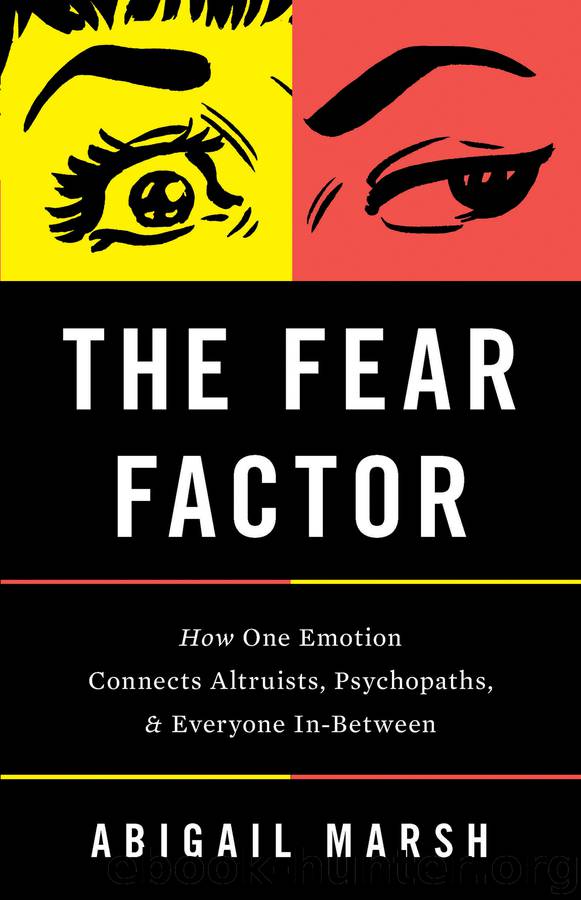The Fear Factor by Abigail Marsh

Author:Abigail Marsh
Language: eng
Format: epub
Tags: Psychology / Psychopathology / General, Psychology / Cognitive Neuroscience & Cognitive Neuropsychology, Science / Life Sciences / Neuroscience
Publisher: Basic Books
Published: 2017-10-10T00:00:00+00:00
The fearful facial expression, which incorporates enlarged eyes, high oblique brows, and a rounded mouth and jaw, causes an adult’s face to more closely resemble the face of an infant. Abigail Marsh.
That fearful expressions evolved to look the particular way they do is almost certain. These expressions, like happiness, anger, and other basic facial expressions, are displayed and recognized by members of many cultures around the world. A meta-analysis conducted by my graduate mentor Nalini Ambady and my colleague Hillary Anger Elfenbein made this clear: they found that in hundreds of studies conducted across dozens of cultural groups around the world, viewers can reliably interpret the meaning of fearful, angry, happy, and other expressions displayed by members of even distant cultures. Considering that some of our nearest primate relatives also express their fear, anger, and happiness using similar facial behaviors, it is very unlikely that these expressions are a purely culturally learned or socialized behavior. Instead, these expressions may serve vital functions that have caused them to be evolutionarily conserved across the generations.
The most powerful evolutionary explanations apply across multiple species—much as van Shaik and his colleagues were able to capture the relationship between allomothering and altruism by looking across multiple species of primates. So it is useful to consider the functions that fearful behaviors serve in other highly allomaternal species, like dogs and wolves. Dogs and wolves employ distinctive behaviors when fearful of attack. They crouch down or roll over, fold their legs and tail close to their bodies, and flatten their ears. They may whimper, lick the jaws of the aggressor, or even urinate. Together, as explained earlier, these behaviors usually trigger the observer’s Violence Inhibition Mechanism and save the cringing, crouching wolf from harm. But why do these behaviors inhibit violence? Or, to alter the emphasis slightly, why do these behaviors inhibit violence? Because, together, they cause the fearful wolf or dog to take on the appearance and other key traits of the one creature that social mammals who bear altricial young are very unlikely to attack: a baby. Key stimuli that set wolf pups apart from their parents are their small size, supine posture, and flattened ears. Pups also emit high-pitched cries, lick their parents’ jaws to request food, and sometimes pee on themselves. That is how these cues inhibit violence: in combination, they very effectively trip not just the aggressor’s “baby!” alarm but the even louder and clangier “oh my God, a baby is in trouble!” alarm, which rapidly suppresses the urge to attack and replaces it with care.
Human fearful expressions, it seems, may do precisely the same thing—as do other fearful cues, like crouching, frightened body postures, or shrill, high-pitched, fearful screams that echo the high-pitched cries of infants. By signaling both distress and infantile vulnerability, these expressions of fear are tailored with extraordinary precision to move those who encounter them to care. The moral philosopher Adam Smith seems to have intuited this when he wrote: “The plaintive voice of misery, when heard at a distance, will not allow us to be indifferent about the person from whom it comes.
Download
This site does not store any files on its server. We only index and link to content provided by other sites. Please contact the content providers to delete copyright contents if any and email us, we'll remove relevant links or contents immediately.
| Administration & Medicine Economics | Allied Health Professions |
| Basic Sciences | Dentistry |
| History | Medical Informatics |
| Medicine | Nursing |
| Pharmacology | Psychology |
| Research | Veterinary Medicine |
The Art of Thinking Clearly by Rolf Dobelli(9853)
The 5 Love Languages: The Secret to Love That Lasts by Gary Chapman(9225)
Mindhunter: Inside the FBI's Elite Serial Crime Unit by John E. Douglas & Mark Olshaker(8669)
Becoming Supernatural by Dr. Joe Dispenza(7810)
The Road Less Traveled by M. Scott Peck(7257)
Nudge - Improving Decisions about Health, Wealth, and Happiness by Thaler Sunstein(7216)
Mastermind: How to Think Like Sherlock Holmes by Maria Konnikova(6912)
Enlightenment Now: The Case for Reason, Science, Humanism, and Progress by Steven Pinker(6856)
Win Bigly by Scott Adams(6802)
The Way of Zen by Alan W. Watts(6271)
Factfulness: Ten Reasons We're Wrong About the World – and Why Things Are Better Than You Think by Hans Rosling(4475)
The State of Affairs by Esther Perel(4463)
Gerald's Game by Stephen King(4355)
Man's Search for Meaning by Viktor Frankl(4235)
The Confidence Code by Katty Kay(4013)
Thinking in Bets by Annie Duke(3986)
The Worm at the Core by Sheldon Solomon(3308)
Hidden Persuasion: 33 psychological influence techniques in advertising by Marc Andrews & Matthijs van Leeuwen & Rick van Baaren(3282)
Enlightenment Now by Steven Pinker(3266)
